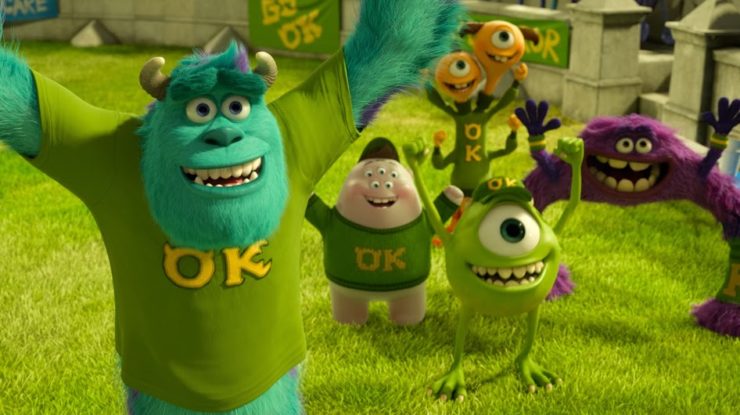If you’re not scary, what kind of monster are you?
The astonishing success of the 1999 Toy Story 2—a movie that managed to outgross its predecessor and earn even better reviews—made Disney even more eager for sequels. When, just two years later, Monsters, Inc. managed to outgross Toy Story 2, Disney believed that they knew what that next sequel could be, and told Pixar creatives to start brainstorming. Disney executives were so eager, in fact, that when Disney and Pixar parted ways in 2005, Disney announced that they would be going ahead with a sequel to Monsters, Inc.
It just wouldn’t be created by Pixar.
This week’s rewatch is very spoilery, since a part of the ending needs discussion.
Disney’s plan was to hand over the potential sequels to a new Disney division—Circle 7 Animation. Tasked with creating sequels to Toy Story 2, Monsters, Inc., and Finding Nemo, the division had just started to make significant progress on the script and early storyboarding for Monsters 2 when Disney suddenly announced—just a year later—that it would be buying Pixar, which would allow Pixar to make the three sequels after all. All of the work done so far would be tossed out.
The animators, fortunately, were not: They headed over to the Disney Animation Studios, then still struggling trying to follow Pixar’s success with animated films. The 2005 Chicken Little, the first fully computer animated film from Disney Animation Studios, had been a financial success, but failed to generate the same box office receipts and critical praise as the Pixar films, almost certainly because the film sucked. Tangled, Disney’s first computer animated film to be both a critical and commercial success, was not released until 2010—four years after Disney closed Circle 7 Animation. Disney’s computer animation department still needed some help.
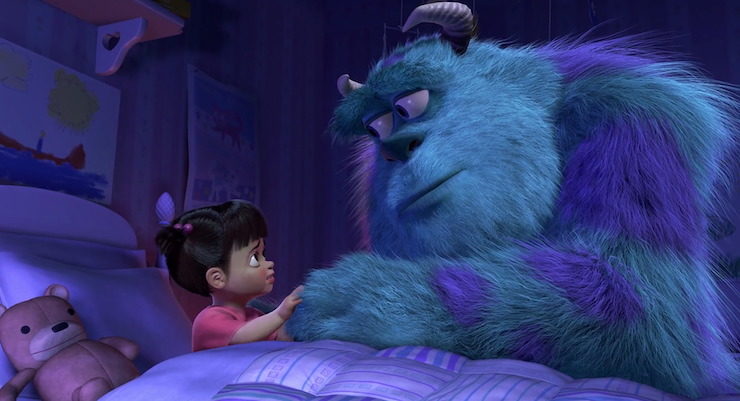
That put Monsters 2 safely back in Pixar’s hands—but also left Disney and Pixar without anything, even concept art sketches, for the sequel. Initially, Pixar was far too busy to worry about this, especially given that during their short period of seemingly leaving Disney forever they had developed ideas for several more non-sequel films, but the commercial success of Monsters, Inc.—and its toys and other merchandising—could only be denied for so long. In 2010, Pixar announced that yes, a sequel to Monsters, Inc. was back in development—and that the other delayed sequel, Finding Nemo 2, would certainly be along soon.
The only thing was, Pixar animators ended up delivering not the long awaited sequel, but a prequel.
The decision made a certain amount of creative sense. Monsters, Inc. had solved the major issues facing monster society: the difficulty of obtaining energy from children’s screams. The solution didn’t even require any technological or other major changes. A sequel could perhaps have explored the lives of monsters unable to transform into comedians—but as a story hook that would provide enough action to fill a movie targeted at kids, it seemed lacking. And even beyond that, everything else had been neatly tied up into a happy ending, leaving Monsters, Inc. with very little room to go forward.
But a prequel? One that showed off how exactly the monsters were trained to scare kids in the first place? That could work—and allow Pixar the opportunity to gently satirize a film genre that they had not yet touched: the college film. On the other hand, it also ran the risk of creating continuity errors—something that the directors decided to just accept.
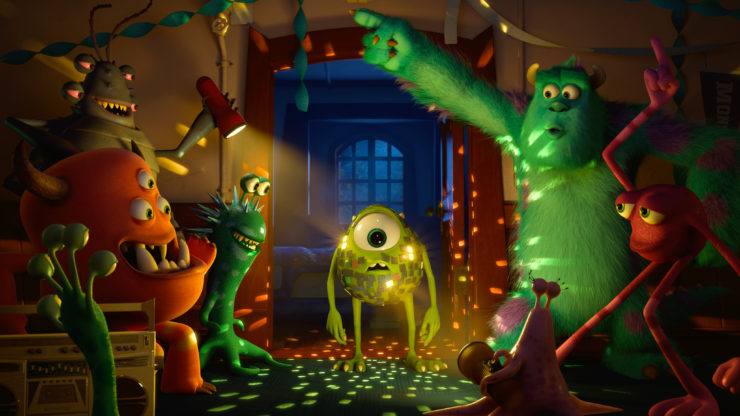
To write and direct the film, Pixar tapped Dan Scanlon, who had worked as a story artist on Cars 2 and as part of the creative team on Brave. Prior to that, Scanlon had also worked on a number of the more questionable Disney direct-to-video sequel films, including Tarzan 2, 101 Dalmatians 2: Patch’s London Adventure, and Little Mermaid 2: Return to the Sea, which if not exactly portents of high creativity and talent, at least demonstrated that he had some experience working to create sequels to popular Disney properties that were at least good enough to keep small children quiet for one or two minutes. (And in Scanlon’s defense, he was not involved with many of the worst of those direct-to-video sequels.)
The return to Pixar ensured that the film could tap all of the original voice actors, most notably Billy Crystal, John Goodman, and Steve Buscemi. And by now, the Pixar films were prominent and prestigious enough to attract stars such as Helen Mirren, Nathan Fillion, and Alfred Molina to play new characters (respectively) Dean Abigail Hardscrabble, Johnny J. Worthington, and Professor Derek Knight. Aubrey Plaza voiced Claire Wheeler, a monster with a suspicious resemblance to Aubrey Plaza, and other actors came in to voice or cameo minor roles—including now reliable Pixar stalwart John Ratzenberger, playing a mail room employee in a nod to his role on Cheers.
Pixar also took the opportunity to upgrade their rendering software and do additional tweaks to their background animation art. The result was astonishing: Monsters University has several shots that, if I didn’t know better (and hadn’t investigated) I could have sworn were a mix of live action film and animation. Particularly impressive were the dented bus that brings Mike to Monsters University, the cobblestone and brick floors of Monsters University, and a scene where Sulley runs through a dark forest in the world of the humans.
Sidenote: As an added bonus, Monsters University enjoyed the hands-down best digital transfer that I’ve seen yet for this entire project. You’re still probably slightly better off with the Blu-ray, depending upon your sound system, but only slightly: This is a crisp, lovely, transfer without a single missing pixel, and it’s not really the sort of action film demanding the very best in sound quality. Feel free to stream this one, everyone.
And, as they had with Cars 2, Pixar took the opportunity to slightly shift the major protagonists. Monsters, Inc. had largely been Sulley’s story. Monsters University would be Mike’s.
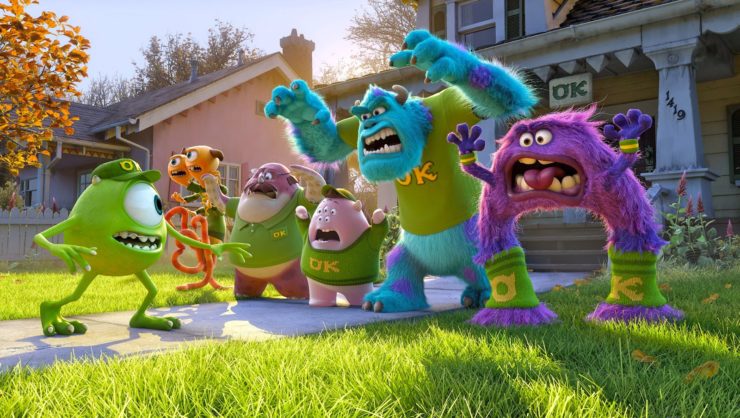
Monsters University starts out with an adorable little Mike monster taking a field trip with other students to the great institution of Monsters, Inc. When I say adorable, I mean, adorable: Everything about little Mike, from the voice of kid actor Noah Johnson (who would go on from this to voice Schroeder in Peanuts, and who I hope to hear more from after he graduates school) to the animation is so adorable that I want to reach through the screen and squeeze and cuddle him. (Yes, I know, Disney has plenty of merchandise to let me do that.) Alas, Mike’s classmates do not agree, refusing to buddy up with him and leaving him with—sniffle—the teacher. And he’s too little to see through the other monsters and the other younger monsters say that he doesn’t belong on the Scare Floor. An upset but still adorable little Mike sneaks onto the Scare Floor anyway and right through one of the doors to the human world. In the ensuing drama, he gets a hat from one of the star Scarers—I was reminded of the similar scene in Indiana Jones and the Holy Grail—and Mike knows what he wants to do with his life: scare kids. Er. Yay?
The place to learn how to do this is Monsters University, so, a few years and some intense studying later, an older Mike—now voiced by Billy Crystal again—finds himself at that majestic institution, helping to show off Pixar’s updated rendering software, sharing a room with one of his future coworkers, the social-climbing Randall. He also finds himself taking monster classes with Sulley, who, unlike Mike, is large, intimidating, and the son of a famous Scarer.
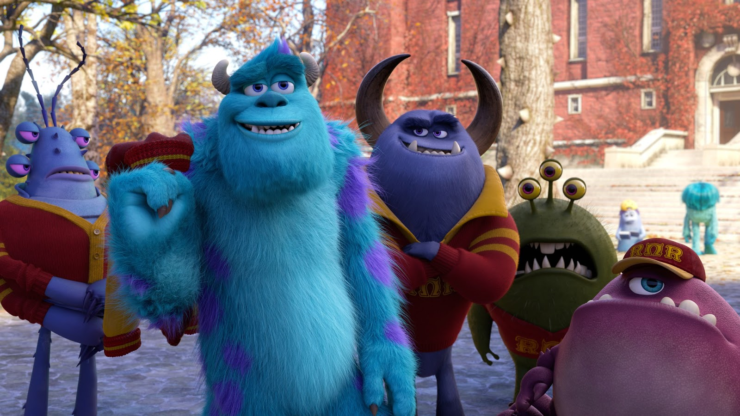
As Mike later bitterly points out, he had to work hard to get into Monsters University and the program; Sulley didn’t. Their combined resentment and irritation leads to a major disruption during an important final, getting both of them kicked out of the program—and in Sulley’s case, out of the most popular and prestigious fraternity on campus, Roar Omega Roar, which is almost worse. Randall, naturally, takes his place. All seems doomed, until Mike decides to enter the Scare Games in order to prove that yes, he can be in the Scare program, and recruits a team of unlikely monsters to join him—including Sulley.
You can probably guess where all of this is going. Yes, everyone laughs at the unlikely monsters, who at one point even get harassed with a stunt right out of Carrie. (This being a cute kid’s film, the response is not quite as horrific.) Yes, Sulley and Mike both misunderstand the first event of the Scare Games and almost lose. Yes, the unlikely monsters help to save the day. And yes, of course Sulley, Mike, and the other unlikely monsters, thanks to both their own efforts and some ineptness on the part of the other monsters, forcing them to face their major rivals, Roar Omega Roar.
Which is about when the film takes its first somewhat unexpected turn: Team Incompetent Monsters (they had another name in the film, but never mind) actually wins the Scare Games, which, ok, is expected, but does so only after some slightly odd behavior from Sulley.
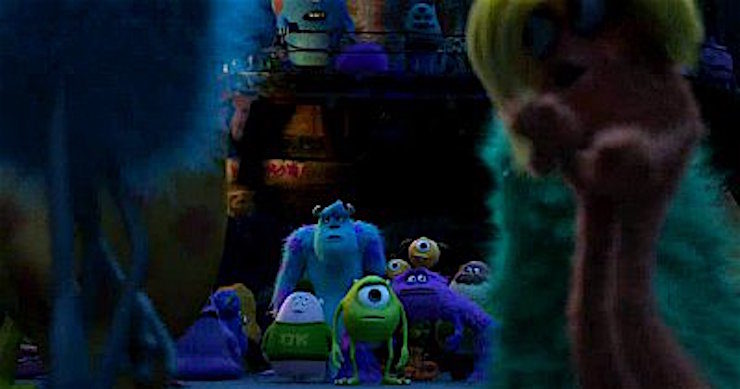
Because, as it turns out, Sulley is cheating.
Which is a little less expected.
I did mention that this is a kid’s movie, and—in theory, at least—Sulley is one of the good guys?
As it turns out, Sulley’s cheating is well-meant. Sure, he’s cheating in part because he’ll be out of the university, and a disgrace to his family, if his team loses the Scare Games, but making his family proud really isn’t Sulley’s major goal in life. On the other hand, he knows that Mike will be devastated if the team loses, kicking Mike out of Monsters University.
And Sulley knows that if he doesn’t cheat, that will happen: Mike is just not scary, and no matter how much time Mike spends studying the appropriate responses for each type of child, and works on his growls and snarls and terrifying expression—Mike will never ever be scary.
So, Sulley cheats.
Which means that the final message of Monsters University kinda comes across as, if you haven’t got the ability to achieve your dreams, you won’t—no matter how hard you work and study and try. Especially if, like Mike, you lack the right look. It’s not really Mike’s talent or skills that are in question, after all—he’s easily able to come up with highly successful scare tactics against adult humans. It’s that he looks like a small walking eyeball, and that, apparently, just isn’t scary. Or scary enough.
It’s a realistic message, for sure—I, for one, was never going to be able to achieve my dreams of being a beautiful ice skater for any number of reasons (though, to be fair, not practicing nearly as much as, say, Mirai Nagasu, was also presumably a small factor). But it’s also an odd one for a kid’s film, and in particular, an odd one for any film distributed by Disney, which had nearly always argued that dreams really could come true—in their films and at their theme parks, at least, if not in the real world.
And, too, if Mike never does—and can never—get his dream job, he does get something else he’s desperately wanted: acceptance and a friend. A real friend, not just the sort of friend who will grudgingly agree to study for a bit and then abandon him for the cool kids club (Though, to be slightly fair to Randy here, that cool kids club does include Nathan Fillion, so although this is not exactly one of Randall’s kinder moments, I think we can all agree that it’s one of his more understandable ones.)
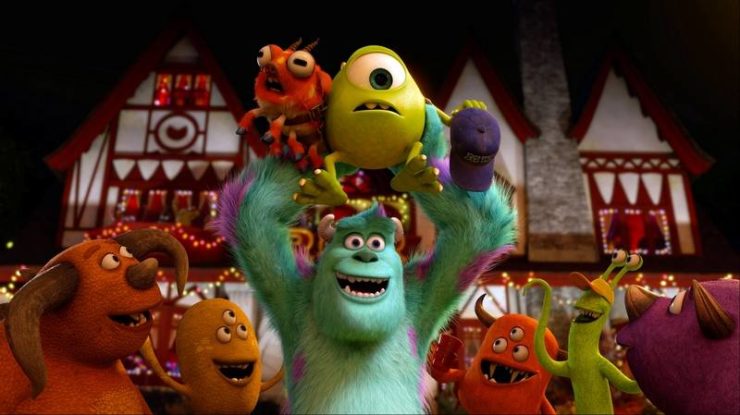
And, as Mike admits, he wanted something else as well:
I thought that if I wanted it enough, I could show everybody that Mike Wazowski was something special.
Since this is a prequel, Sulley can’t exactly point out that Mike is featured on any number of Disney Trading Pins and other merchandise. What Sulley can and does do is join Mike on a wild and desperate attempt to terrify a number of adult humans. It’s a wild success, so much so that the two not only manage to bring themselves back to the monster world, but also power up nearly every monster battery in their vicinity. Even the university dean can’t explain how they managed it.
Something special, indeed.
So Mike gets something, at least. Along with learning this about Sulley:
I act scary, Mike. But most of the time, I’m terrified.
Monsters University also contains some delightfully sly moments—a bit showing an Aquatics School located underwater, because, water monsters; a scene where a few monsters gleefully rejoice in eating garbage (since quite a few of them somewhat resemble Muppets, and thus, Oscar the Grouch, this makes quite a bit of sense); every bit of dialogue voiced by Helen Mirren, and the visual homages to Helen Mirren. It also somewhat answers one of the lingering questions from the first film—namely, how did all of those magical bedroom doors end up the world of monsters? (SCIENCE, kids! SCIENCE!)
It’s hardly a perfect film. As noted, the first two-thirds of the film tend to be incredibly predictable, and Randy’s transformation from Mike’s roommate and friend to evil villain, while somewhat foreshadowed in a few offhand comments, and certainly needed for the next film, just feels a bit too abrupt. The film’s very existence raises a few questions about Monsters, Inc.—not just Mike’s line in that film that he’s known Sulley since fourth grade (something contradicted in this film) but something much more fundamental: As this film shows, the monster world knew that energy could be harvested from something other than the screams and fears of small children. That is, the screams of adults. So, why didn’t Monsters, Inc. investigate this when the power sources began to dwindle? Randall, for one, certainly knew about this—and Randall strikes me as the sort who would be delighted to terrorize adults if it meant keeping his lights and Jacuzzi on. And I have to say, I’m kinda surprised that neither Mike nor Sulley seems to remember their previous visits to the human world as grownup monsters at Monsters, Inc.
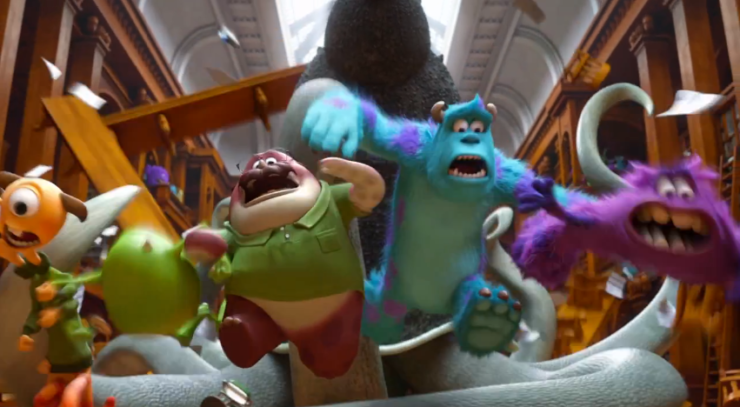
And much though I’m a fan of encouraging small children to be quiet in libraries, I can’t say I’m entirely thrilled with the decision to present a librarian as one of the scariest people in the film/tosses students out of the library, especially since what I mean by “tosses” here is “fling them through the roof and make them land in a pond.” Monsters clearly can endure more physical pain than we can, but, still. Especially since this eventually results in a scene of monsters creating massive disturbance and destruction in a library. Go watch Beauty and the Beast again, Pixar animators, and learn some respect for animated libraries.
But for a film about a world of monsters, it’s surprisingly realistic, and a little bit different than the usual Disney or Pixar film.
And I have to admire any film that allows Billy Crystal to make a The Princess Bride joke.
Monsters University was a solid box office success, bringing in $744.2 million worldwide. For the most part, critics liked the film, though almost everyone seemed to agree that it was only good, not great—not necessarily a bad thing, but not exactly up to Pixar’s standards, either. It was also, in a stunning reversal, soundly defeated at the box office later that year by Disney’s Frozen—the first year that a Disney film beat a Pixar film released in the same box office year. And although it received a number of nominations for various industry awards, to nearly everyone’s shock, it was not nominated for an Academy Award for Best Animated Feature—only the second time a Pixar film had missed that recognition. (The first was Cars.)
The usual merchandise hit the shelves, and children seemed delighted by the film and eager for more of Mike and Sulley. Pixar, however, wanted a slight break from the prequel/sequel films, and also, as usual, was scrambling to meet deadlines.
Inside Out, coming up next month.
Mari Ness lives in central Florida.










